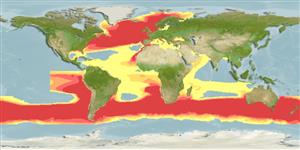Preferred temperature (Réf.
123201): 3.1 - 16.3, mean 7.8 °C (based on 1486 cells).
Phylogenetic diversity index (Réf.
82804): PD
50 = 0.7813 [Uniqueness, from 0.5 = low to 2.0 = high].
Bayesian length-weight: a=0.01047 (0.00604 - 0.01816), b=3.03 (2.87 - 3.19), in cm total length, based on LWR estimates for this species & (Sub)family-body (Ref.
93245).
Niveau trophique (Réf.
69278): 4.6 ±0.0 se; based on diet studies.
Generation time: 9.5 ( na - na) years. Estimated as median ln(3)/K based on 1
growth studies.
Résilience (Réf.
120179): Très faible, temps minimum de doublement de population supérieur à 14 ans (K=0.12; tm=5; tmax=30; Fec=1-5).
Prior r = 0.05, 95% CL = 0.03 - 0.07, Based on 3 full stock assessments.
Fishing Vulnerability (Ref.
59153): High to very high vulnerability (74 of 100).
🛈
Climate Vulnerability (Ref.
125649): High vulnerability (62 of 100).
🛈
Nutrients (Ref.
124155): Calcium = 2.77 [0.73, 15.82] mg/100g; Iron = 0.301 [0.075, 1.026] mg/100g; Protein = 19.2 [16.9, 21.6] %; Omega3 = 0.387 [0.159, 0.924] g/100g; Selenium = 16 [5, 47] μg/100g; VitaminA = 6.86 [1.47, 34.61] μg/100g; Zinc = 0.202 [0.100, 0.381] mg/100g (wet weight); based on
nutrient studies. 